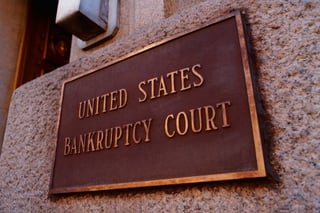
An order for relief in bankruptcy is the official court ruling that initiates the bankruptcy process after a petition is filed. It immediately triggers the automatic stay, which halts all creditor collection efforts, including lawsuits, wage garnishments, and foreclosure actions.
.
The order for relief sets the framework for the case, ensuring creditors are notified and a trustee is appointed to manage the debtor's estate. This legal mechanism provides the debtor with temporary relief while their financial situation is addressed in bankruptcy proceedings.
A knowledgeable Minnesota bankruptcy attorney can explain details about how an Order for Relief works in Minnesota, what types of creditors typically file Motions for Relief, and what happens if it's granted. Plus, it's helpful to get some background what an order for relief means.

Overview on the Automatic Stay in Bankruptcy in Minnesota
The moment a debtor files for bankruptcy in Minnesota, an automatic stay goes into effect. This is an essential protection provided by the order for relief. The automatic stay acts as a legal shield, immediately stopping most collection actions by creditors. It prevents wage garnishments, foreclosures, repossessions, and phone calls demanding payment.
The automatic stay is triggered as soon as the bankruptcy petition is filed, and its purpose is to give the debtor breathing room to reorganize their finances without constant pressure from creditors. However, there are some exceptions to this rule, as not all debts are subject to the automatic stay. For example, child support obligations and certain tax liabilities may not be halted.
For Minnesota residents, the automatic stay offers crucial relief, especially for those facing the threat of foreclosure or wage garnishment. Knowing that the moment they file for bankruptcy, creditors must stop collection activities can provide a significant sense of relief during what is often a stressful and overwhelming time.
How Long Does the Automatic Stay Remain in Effect?
In Minnesota, the length of the automatic stay depends on the type of bankruptcy you file and the circumstances surrounding your case. For Chapter 7 bankruptcy, the automatic stay typically remains in place until the case is closed or dismissed, or until the debtor receives a discharge. This process can take a few months.
In a Chapter 13 bankruptcy case, the automatic stay can last for the entire duration of the repayment plan, which typically spans three to five years. During this time, the debtor is expected to make regular payments toward their debts, and creditors are prohibited from taking action to collect those debts outside of the bankruptcy plan.
It’s important to note that creditors in Minnesota can request that the court lift the automatic stay under certain circumstances, such as if the debtor fails to make required payments or if the property is not essential to the debtor’s financial reorganization. This brings us to the concept of “motions for relief” and why they might occur during a bankruptcy case.
Orders for Relief from the Automatic Stay
The Automatic Stay is what protects you from your creditors during the life of your bankruptcy. Think of it as an invisible and impenetrable blanket surrounding you that prevents your creditors from contacting you or collecting from you.
More often than not, the earliest relief that comes with bankruptcy begins upon filing your case. That is because the moment a bankruptcy case is filed the Automatically Stay simultaneously comes into effect. The Automatic Stay prevents creditors from contacting or collecting from bankruptcy debtors. Imagine a world where creditors can’t call you, they can’t send you mail, and they can’t take you to court. That is what the world looks like with the Automatic Stay. Nice, isn’t it?
Creditor's Motion for Relief
Unfortunately, there are rare circumstances in which the Automatic Stay cannot protect you from certain creditors. Certain creditors can file a Motion for Relief from your Automatic Stay. If granted, an Order for Relief allows the creditor to contact and collect from you.
In order to get around the Automatic Stay, a creditor must file a Motion for Relief with the Bankruptcy Court. The Motion for Relief is the creditor’s way of asking the Court for permission to contact and collect from a debtor during the life of a bankruptcy. In order to do so, the Court must hold a hearing on the Motion for Relief and the Court must grant an Order for Relief to the creditor.
What Types of Creditors Typically File Motions for Relief?
Secured Debts: Car Loans and Mortgages
The most frequent filers of Motions for Relief are secured creditors. A secured creditor is a creditor whose debt is perfected and attached to property that the debtor owns (i.e., car loans and home mortgages).
More often than not, the secured creditor files for a Motion for Relief after the debtor has missed one or more payments on the secured debt. What the secured creditor is seeking is the Court’s permission to contact the debtor to either 1) collect payment, or 2) seize the secured property.
Criminal Restitution/Child Support/Spousal Support
There are times when creditors file Motions for Relief for non-dischargeable debts like criminal restitution, child support, or spousal support. Such debts are not dischargeable in bankruptcy, meaning they must still be paid by the debtor. Why would such creditors file a Motion for Relief?
Usually, it is because the funds have an immediate need or impact on the creditor. Take child support, for example: if child support is not being paid while a debtor is in bankruptcy, but the child or parent owed the child support needs the support in order to survive financially, they may file a Motion for Relief to collect payment of the child support during the bankruptcy.
If granted an Order for Relief, the debtor must resume paying child support.
Credit Card Companies
While credit card companies very rarely file Motions for Relief, it does happen. A credit card company can seek an Order for Relief if it feels the debtor made fraudulent charges before filing bankruptcy. Some examples include: extravagant spending, gambling debts, or cash advances immediately prior to filing bankruptcy. If an Order for Relief is granted, the credit card company can resume contacting the debtor, collecting payment, or pursuing a judgment for the outstanding balance.
When and Why Do Creditors Make Motions for Relief?
Creditors may file a motion for relief from the automatic stay if they believe they have a valid reason to continue collection efforts despite the bankruptcy filing. In Minnesota, creditors often seek relief from the stay if they feel their interests are not being adequately protected, or if they believe the debtor is misusing the bankruptcy process.
For instance, if a debtor has filed for Chapter 7 bankruptcy and is behind on mortgage payments, a mortgage lender may file a motion for relief from the stay to proceed with foreclosure. The court will then decide whether to grant or deny this request based on the facts presented.
Another common scenario occurs in Chapter 13 cases, where creditors may seek relief from the stay if the debtor fails to make required payments under the repayment plan. In these cases, creditors must demonstrate to the court that lifting the stay is necessary to protect their financial interests.
In Minnesota, it’s important for debtors to remain aware of their financial obligations during bankruptcy to prevent creditors from filing motions for relief. Failing to keep up with payments or attempting to delay the process can lead to negative outcomes, such as the loss of critical property like a home or car.
Motion for Relief if You're Current on Your Loan
In general, creditors are less likely to file a motion for relief from the automatic stay if you are current on your loan payments, particularly for secured debts like mortgages or car loans. However, there are exceptions where creditors may still seek relief even if you are up to date on your payments.
One reason a creditor may file a motion for relief in this situation is if the property in question is not adequately insured, putting their collateral at risk. For example, if your car is financed and you’ve stopped paying for insurance, the lender may request relief from the stay to repossess the vehicle and minimize their risk.
Another reason could be if you have filed multiple bankruptcies within a short time frame, which could signal abuse of the bankruptcy system. In this case, creditors may argue that they should be allowed to resume collection efforts, as the debtor’s actions indicate an intent to delay payments rather than seek genuine financial relief.
In Minnesota, it’s crucial to maintain communication with your creditors and ensure that you are meeting all obligations, such as keeping assets properly insured, to prevent unnecessary motions for relief from the automatic stay.
What Happens if an Order for Relief is Granted?
Once an Order for Relief is granted, it is like the Automatic Stay no longer exists for that specific creditor. Now the creditor can contact the debtor through mailings, phone calls, or collection agencies.
They can also repossess any secured collateral (if a secured creditor) or start a lawsuit against the debtor for the money owed. If a creditor is granted an Order for Relief and pursues a judgment against a debtor, the debtor’s bankruptcy provides no defense to this judgment.
If an Order for Relief is granted in a bankruptcy, the debtor’s best options are to either:
-
Pay the debt to the creditor.
-
Surrender any secured property back to the creditor.
What Else Happens When I File Bankruptcy in Minnesota?
Filing for bankruptcy in Minnesota sets off a chain of events beyond just the automatic stay. After filing, the court will issue an order for relief, which officially starts the bankruptcy process. Here’s a look at some other important steps that happen when you file for bankruptcy:
-
Appointment of a Bankruptcy Trustee
Once the order for relief is issued, a trustee will be appointed to oversee your bankruptcy case. This trustee is responsible for reviewing your financial situation, managing your bankruptcy estate, and ensuring that your creditors are paid in accordance with bankruptcy laws. -
The 341 Meeting of Creditors
In both Chapter 7 and Chapter 13 bankruptcies, you will be required to attend a 341 meeting of creditors. This meeting allows creditors to ask questions about your financial situation and the debts you owe. While creditors rarely attend these meetings in person, the trustee will likely have questions for you about your assets, income, and expenses. -
Property Exemptions
Minnesota bankruptcy law allows for certain property exemptions, which protect specific assets from being seized by creditors. Understanding which exemptions apply to you can help safeguard your home, vehicle, and other essential belongings. For example, Minnesota’s homestead exemption may protect a significant portion of the equity in your primary residence.
These steps, combined with the protections provided by the automatic stay, offer a framework for individuals seeking financial relief through bankruptcy in Minnesota. It’s essential to be informed about what happens after filing to ensure you are following the proper procedures and making the most of the relief available.
Legal Help with an Order for Relief in Minnesota Bankruptcy
An order for relief is a critical element of the bankruptcy process in Minnesota, providing immediate protection from creditors through the automatic stay. For those struggling with overwhelming debt, this order represents the first step toward financial recovery.
From understanding how long the automatic stay lasts to recognizing when creditors might file motions for relief, it’s essential to be informed about how this legal process works. If you’re considering bankruptcy in Minnesota, consulting with a qualified bankruptcy attorney can help ensure that you receive the protection and guidance you need to successfully manage your case.
Don’t let overwhelming debt hold you back any longer. Contact LifeBack Law Firm, P.A. for a free consultation to discuss your bankruptcy options and how we can help you find relief. Call us at 844.277.9650 or visit us online now!
FAQs About an Order for Relief in Bankruptcy
What is the meaning of an order for relief?
An order for relief is a court’s formal approval to begin bankruptcy proceedings after a bankruptcy petition is filed. It marks the official start of the case and activates the automatic stay, which halts creditor collection efforts like lawsuits and foreclosures. The order for relief allows the court to oversee the debtor’s finances, protect assets, and ensure creditors follow legal procedures during bankruptcy.
What happens if an automatic stay is lifted?
If an automatic stay is lifted, creditors are allowed to resume collection activities that were previously halted by the bankruptcy filing. This could include pursuing foreclosure, repossession, or wage garnishments. A stay is typically lifted when a creditor files a motion and demonstrates to the court that they are not adequately protected, or the debtor fails to meet their obligations under the bankruptcy plan.
How do you respond to a motion for relief from the automatic stay?
To respond to a motion for relief from the automatic stay, you must file an objection with the bankruptcy court, explaining why the stay should remain in place. Your response should provide evidence showing that the creditor’s concerns are unfounded or that you have made efforts to resolve the issue, such as catching up on missed payments. It's crucial to attend the hearing scheduled by the court to present your case.
Ready to Start Fresh?
If you’re facing financial difficulties, we’re here to help you every step of the way. Schedule your free consultation with LifeBack Law Firm, P.A. today by going online or calling 844.277.9650. Let’s work together to regain your financial stability!





